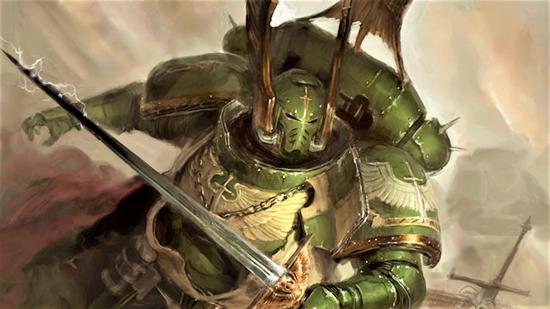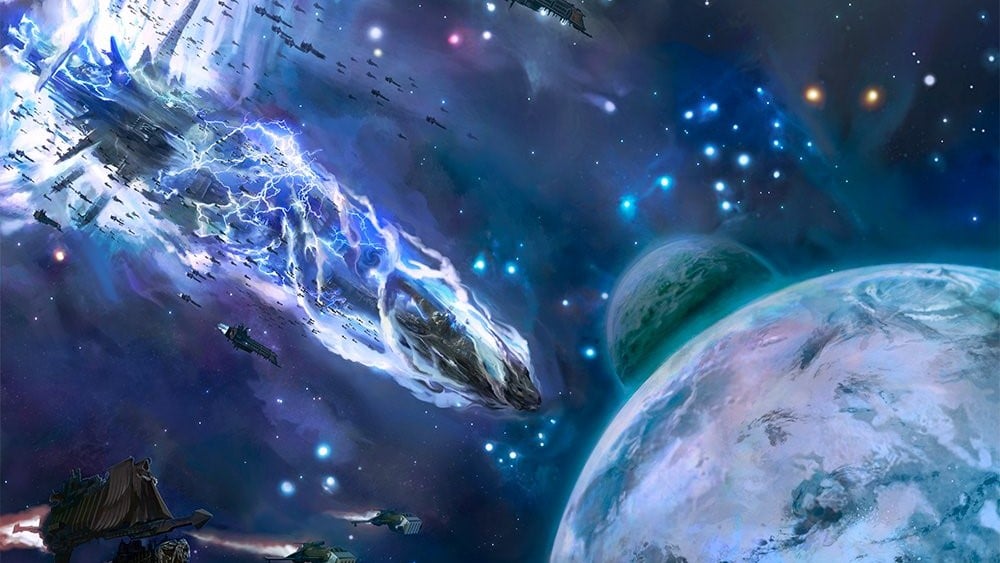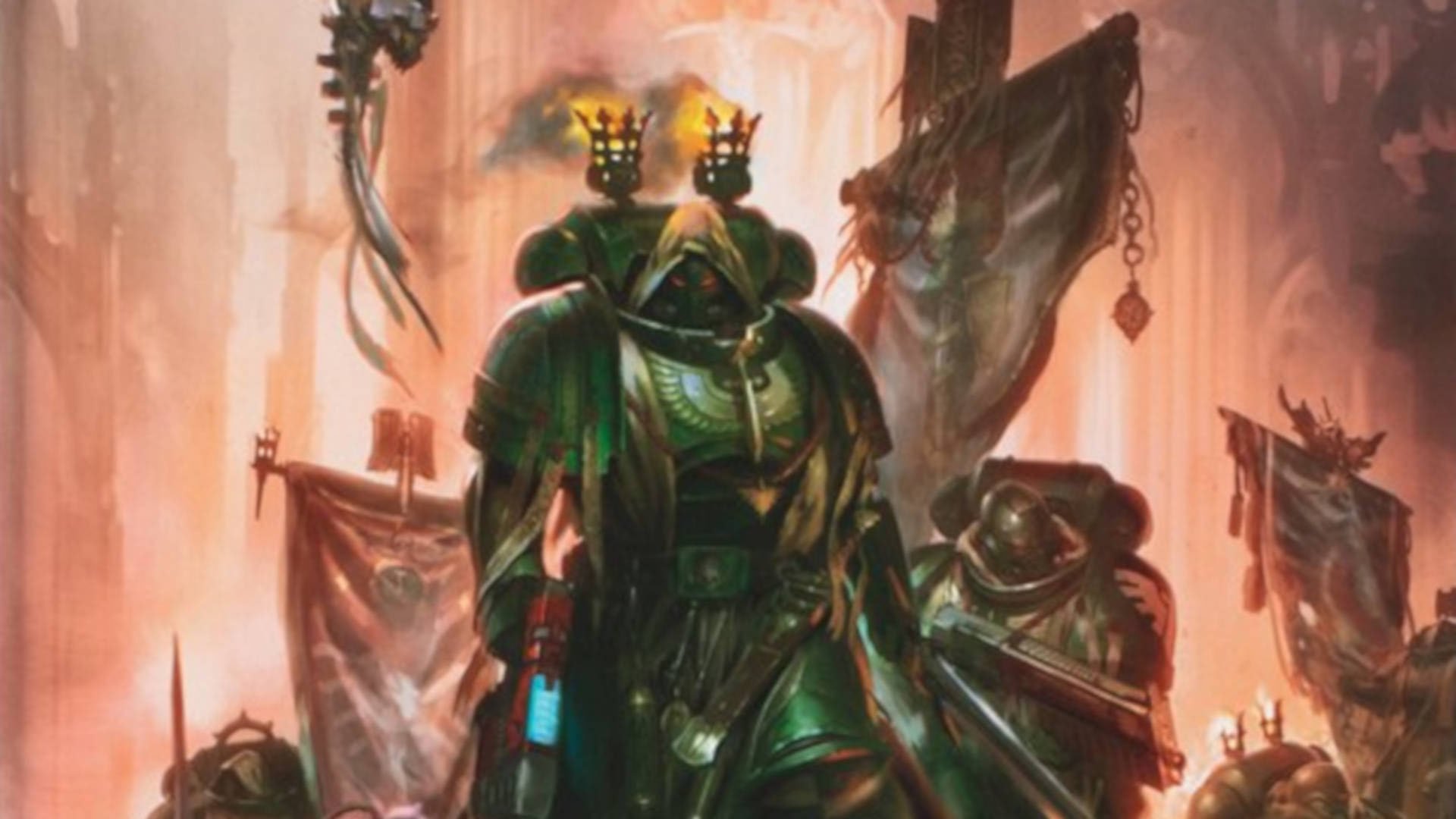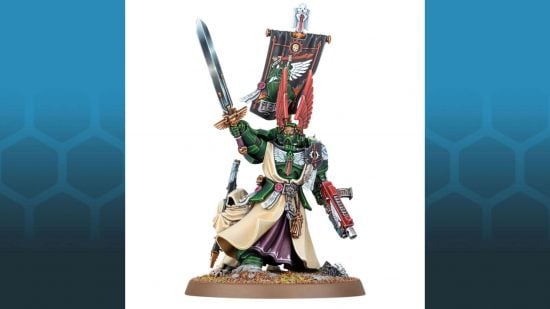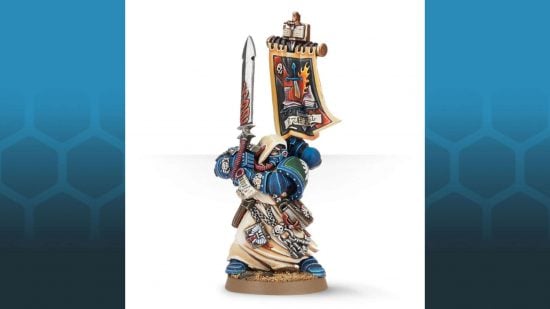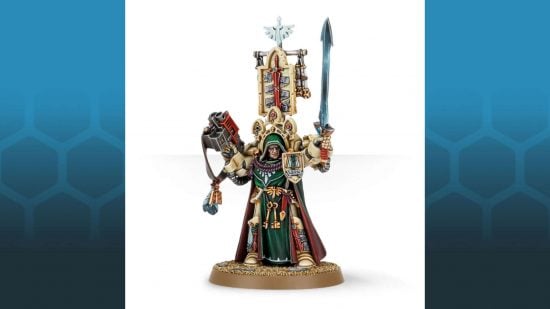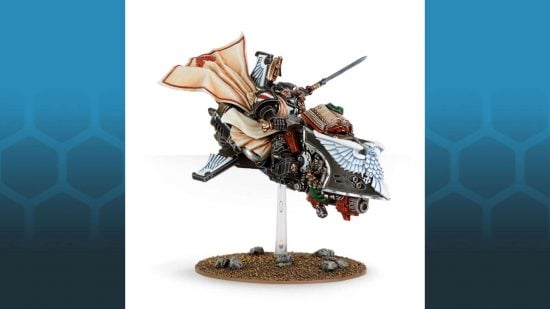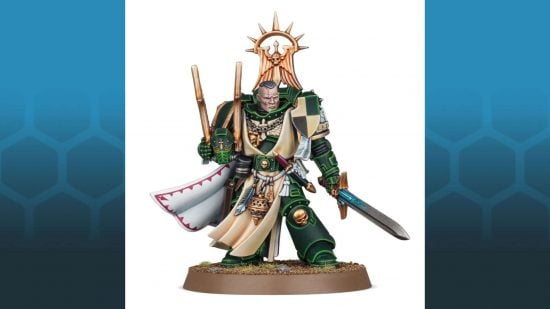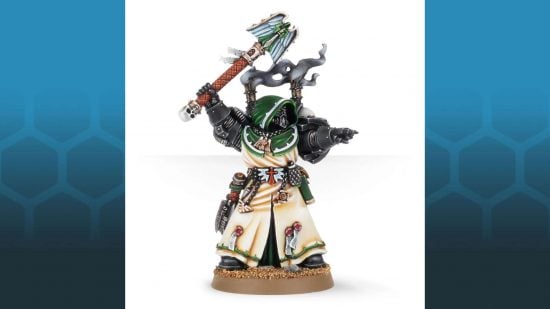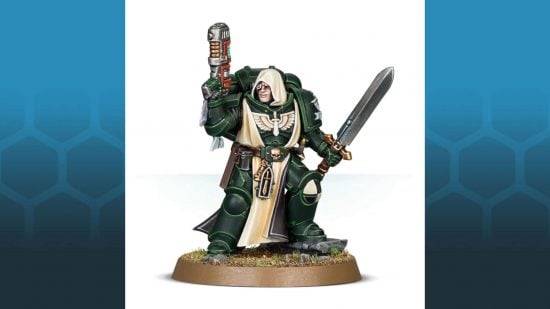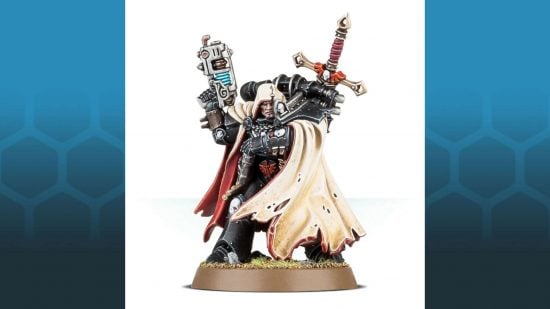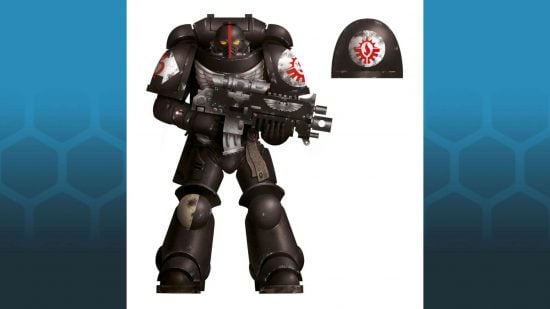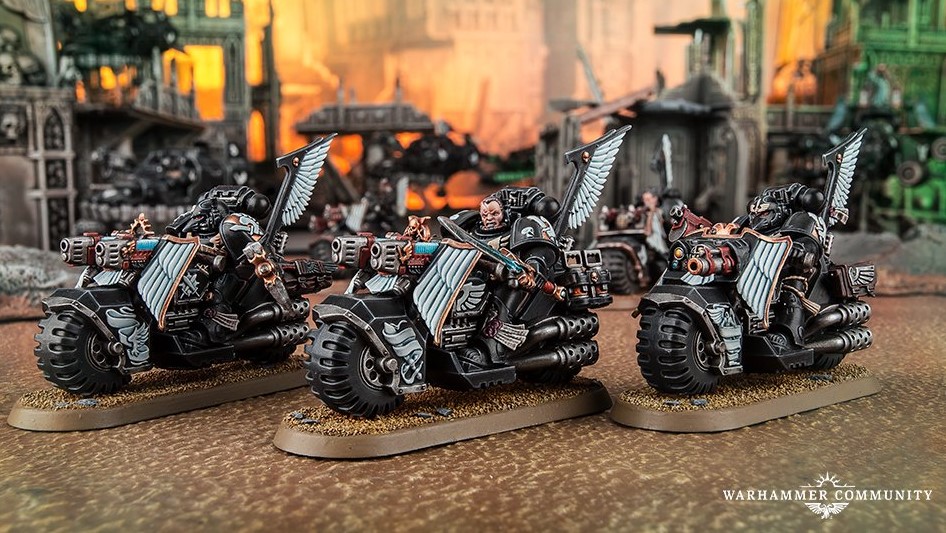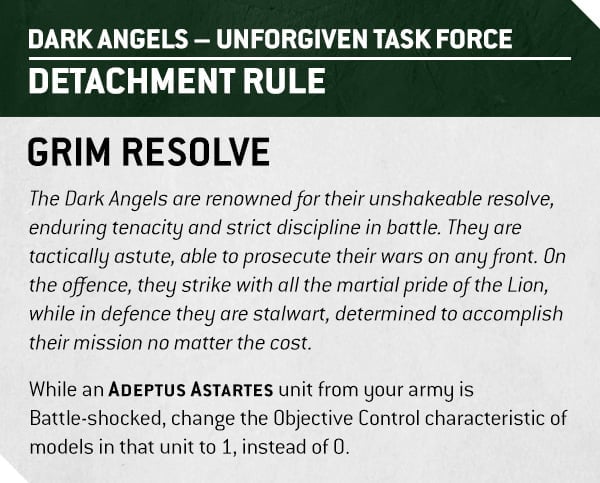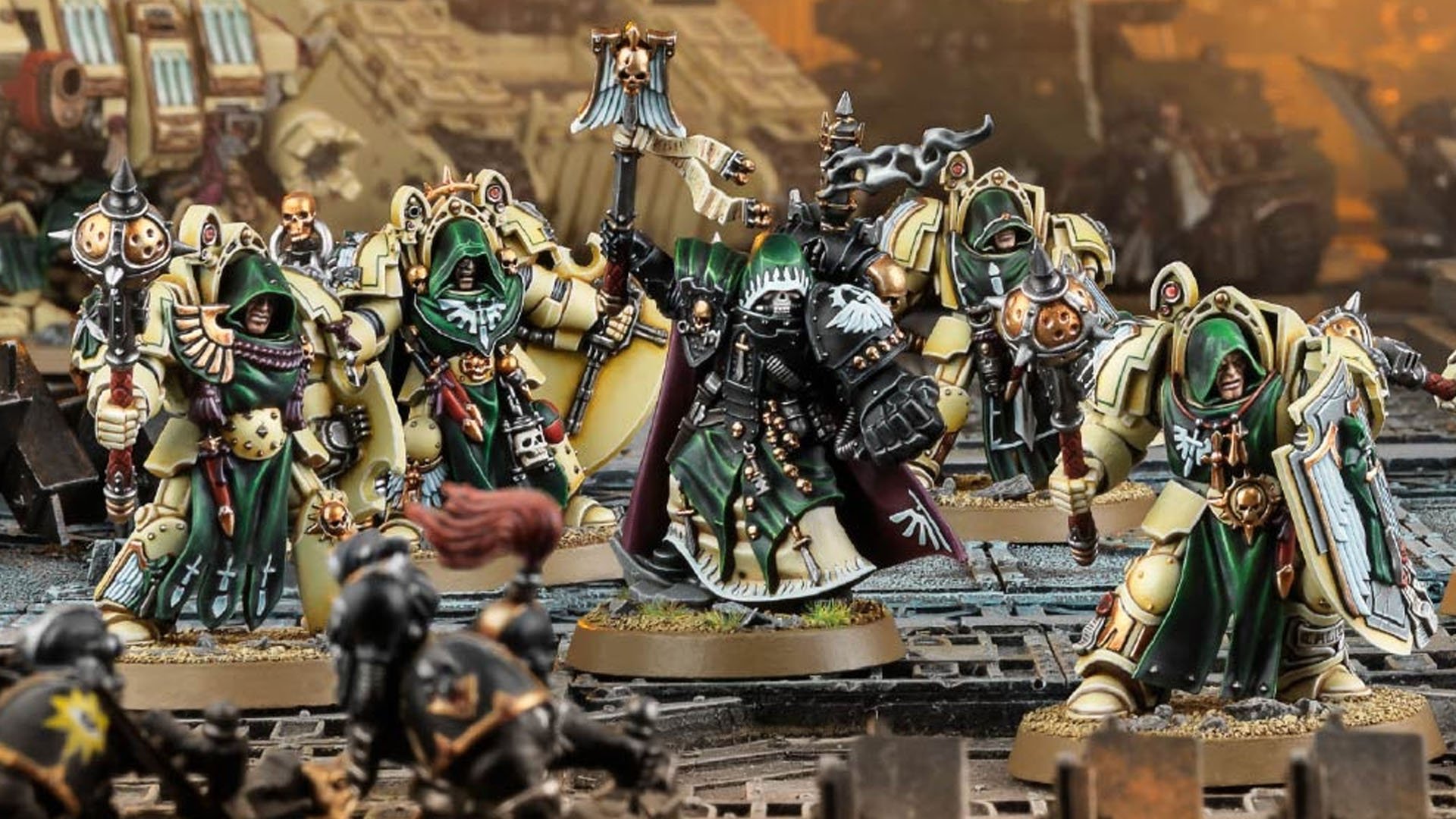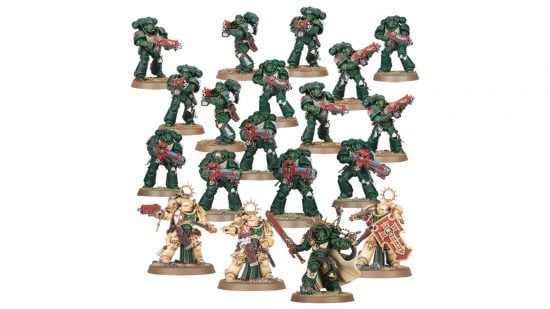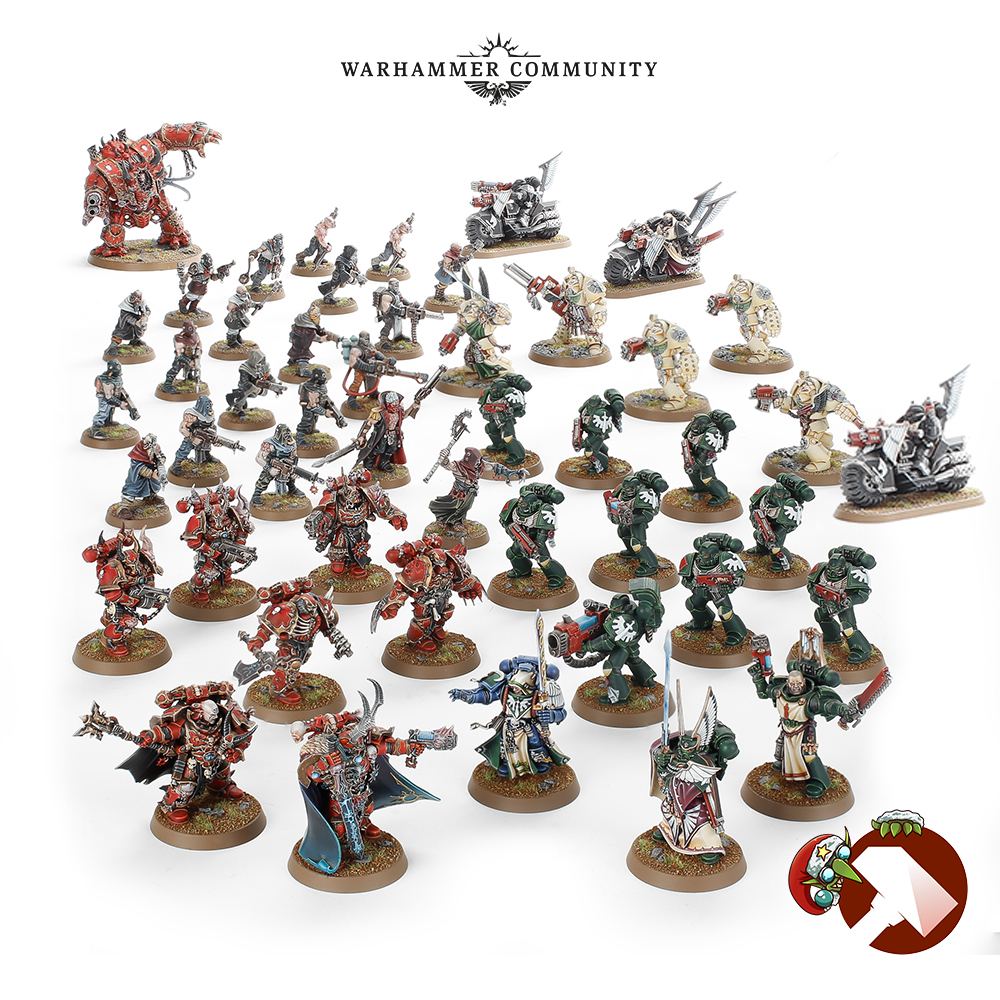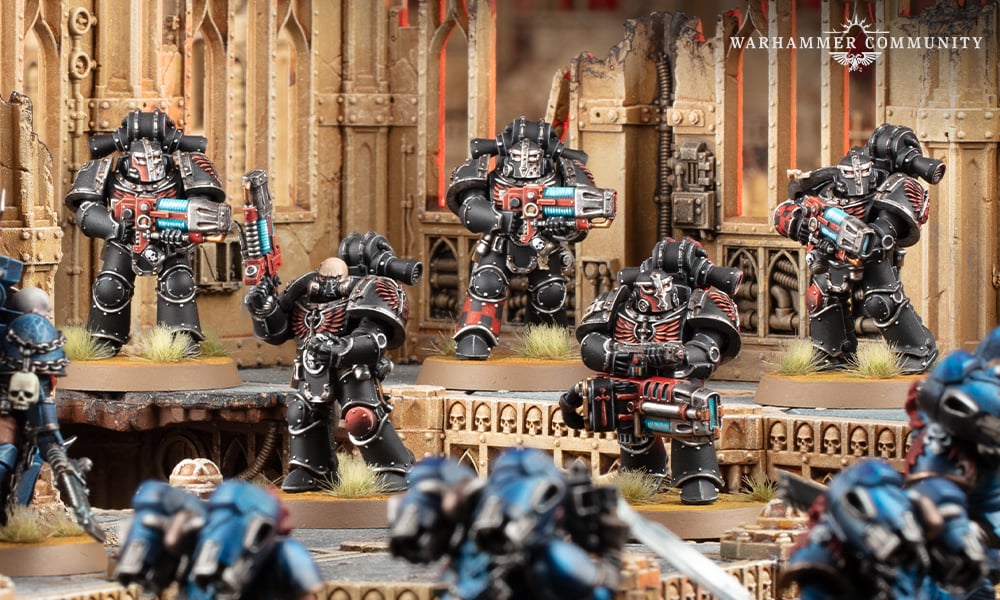The Warhammer 40k Dark Angels are the descendants of the first Space Marine Legion, proud and devoted warriors of the Imperium haunted by a shameful secret dating back to the Horus Heresy. This guide introduces them from every angle – their lore, their most significant characters, unique units, rules for using them in Warhammer 40k and Horus Heresy, and more.
If you’re new to Warhammer 40k as a whole, we have a separate guide that introduces the whole concept of Space Marines. That’s not to mention guides to each of the other Warhammer 40k factions.
This is everything you need to know about the Warhammer 40k Dark Angels:
- Lion El’Jonson and Dark Angels lore
- Pre-Horus Heresy Dark Angels
- The Dark Angels in the Horus Heresy
- The Rock
- The Fallen
- The Inner Circle
- The Deathwing
- The Dark Angels since the Horus Heresy
- The Risen
- Who are the Dark Angels characters?
- Dark Angels Successor Chapters
- Dark Angels books
- Unique Dark Angels units
- Warhammer 40k 10th edition Dark Angels army rules
- Dark Angels strategy
- Dark Angels Combat Patrol box set
- Dark Vengeance
- Dark Angels Horus Heresy rules
Lion El’Jonson and Dark Angels lore
From their first founding, the Dark Angels have been a proud sect of warrior monks. Whilst many other Space Marine Chapters have their own plaudits and reasons to be proud, only one gets to be first and that honor goes to the Dark Angels – originally styled the First Legion Astartes.
Spawned from the gene-Seed of the primarch Lion El’Jonson, they inherited many of his traits. These include a passion for victory, an overwhelming desire for martial perfection, and – unfortunately for their story – a certain arrogance and tendency to keep secrets.
Pre-Horus Heresy Dark Angels
The Dark Angels were the first Legion Astartes created by the Emperor of Mankind’s genelabs. In some regards, they were the archetype from which all other Astartes were derived. Their geneseed was extremely reliable, with a very low failure rate, low rate of mutation, and they were adept in all forms of warfare.
The First Legion was founded on Terra using gene-seed derived from the genetic code of Lion ‘El Jonson. They saw combat in the final stages of the unification of Terra. This included fighting alongside the Custodians to quash a coup attempt led by politicians alarmed by the Emperor’s unilateral and secret decision to execute the remnants of the pre-Space Marine Thunder Warrior legions, and the few Thunder Warriors who had survived the purge on Mount Arrarat.
The First Legion was united with its Primarch, Lion El’Jonson, when the Great Crusade encountered the planet Caliban.

Caliban before the Heresy
The Warhammer 40k Primarchs, the superhuman genetic precursors to the Space Marines, had been scattered across the galaxy by unknown forces while still in their gestation chambers. Lion ‘El Jonson, the first Primarch, landed on the feudal death world Caliban to the galactic north of the Eye of Terror warp rift in Segmentum Obscurus.
Caliban was a planet of deep, haunted forests, inhabited by lethal beasts warped by the touch of Chaos. The planets feudal society was ruled by lords and their knights who governed from the few stony castles, who divided their time between courtly wars of honor, and fighting back the nightmare beasts of Caliban’s dark places.
Luther
When Lion El’Jonson arrived on Caliban, the planet was already entering a period of change. A noble warrior, Luther, had embarked on a quest to unite the many Knightly houses behind a single banner, The Order, and purge the dark places of the world of the beasts that slaughtered the innocent. Chief among his adversaries were the Knights of Lupus, corrupted warriors who sought to harness the nightmare creatures of the deep woods to their own ends.
It was during a beast-slaying quest that Luther came upon the young Primarch, a pristine, perfect human child somehow hearty and whole in a forest crawling with nightmares. Despite his first instinct to slay this obviously incongruous creature, Luther instead took the boy into his care, naming him Lion El’Jonson, or “The Lion, Son of the Forest” in the tongue of Caliban.
Jonson soon matured into a powerful warrior, equalling and then surpassing his mentor and friend in strength, speed, military cunning, and skill at arms. It was only when it came to judging character and gathering support that Luther remained his superior. Together, they marshalled all the banners of Caliban into The Order, putting the Knights of Lupus to the flame and driving the warped beasts to extinction.
The Imperium discovers Caliban
By chance, it was the First Legion Astartes who encountered the planet Caliban and discovered the lost Primarch. When the Emperor learnt of Jonson’s rediscovery, he placed him in charge of the First Legion. Jonson began to reshape them according to the tenets of The Order, a mixture of military doctrine and mystery rite known as the Hexagrammaton.
Those of The Order who had fought beside Jonson were given the option to join the Dark Angels. The younger members were elevated to become full Astartes, while those too old to accept full transformation were given substantial augmetics and enhancements that would allow them to almost equal their skill. Luther accepted this elevation so that he might continue to fight beside his close friend. But the germ of jealousy and suspicion had begun to fester in Luther’s heart.
The schism between Luther and Jonson
Not long after the Dark Angels Legion disembarked to persecute the Great Crusade, they encountered the human-occupied planet Sarosh. This relatively advanced civilization held covert beliefs worshipping the powers of Chaos, but masked them long enough to instigate a diplomatic visit to board the Dark Angels flagship. This was in fact a ruse to smuggle a nuclear warhead onboard the vessel.
The plot was discovered by Luther and a junior librarian, Zahariel, who ultimately ejected the Saroshi shuttle into space before the explosive could detonate. Luther may have known about the plot and allowed it to proceed, wishing to be rid of the former friend who had so far exceeded him, before realising his error. This is what Jonson believed, for he sentenced Luther and five hundred of his closest warriors to return to Caliban, giving the public cover story that they were tasked with driving up the quality of recruits.
For the following fifty years, Jonson pursued the Great Crusade without ever returning to Caliban or summoning Luther, earning glory on many fronts – particularly the dark and terrible Rangdan Xenocides. The rift between Jonson and Luther festered.

The Dark Angels in the Horus Heresy
At the outbreak of the Horus Heresy, the main mass of the Dark Angels fleet was committed to a battle against the human and Xenos alliance known as the Gordian League. Warmaster Horus had engineered the conflict to ensure the Dark Angels were out of position to participate in the retribution fleet dispatched to the Istvaan system.
The battle of Diamat
Rather than effect a costly and hasty withdrawal, Jonson chose a lightning strike target that he and a small battle group could claim vital supplies on Diamat, a Forge-world close to the Istvaan system. This mission was costly but successful, and the Dark Angels were able to secure monumentally powerful siege weapons that had been commissioned by the Warmaster but never used.
Unfortunately for the Imperium, Jonson then transferred the massive siege guns to another Legion that was en-route to Istvaan: the Iron Warriors. Jonson did not suspect his brother Perturabo’s treacherous intent, and hoped to curry favor with his brother in the upcoming election of a new Warmaster he believed would soon ensue after Horus’ execution.
The Thramas Crusade
After the Dropsite Massacre, Horus despatched the Night Lords legion to wage a terror war in the galactic east. Many Forge Worlds loyal to the Imperium were based here, and their loss would be catastrophic. Jonson and his Legion engaged with this conflict, which became known as the Thramas Crusade.
The contest between Jonson and Konrad Curze became deeply personal. Curze invited his brother to parlay on the world of Tsagualsa, but the pair came to blows, saved from death only by the quick action of their honor guards. Afterwards, the Lion would pursue a grudge against the Night Haunter.
The Tuchulcha device
The Dark Angels encountered a running battle between forces of the Iron Hand and the Death Guard in the Perditus system. Not knowing the loyalty of either force, the Dark Angels forced both to disengage. They were able to claim the prize the pair had been fighting over, the Tuchulcha device, a mysterious artefact capable of precise and efficient Warp jumps.
The first test of this device saw the Dark Angels beset by a daemonic host, led by the Greater Daemon of Tzeentch Kairos Fateweaver. The First Legion had experience battling horrors of unreason, and Jonson put the Lord of Change to the sword. In the process of fighting back, Jonson broke the Edict of Nycea which forbade the use of the Librarius within the Space Marine Legions, a decision that some within the Legion opposed.
The second use of the Tuchulhca allowed the Dark Angels to launch a backbreaking precision strike against the Night Lords fleet. Fully a quarter of the traitor vessels were crippled. However, Jonson could not deliver the killing blow on the Night Haunter, and the traitor launched a teleport counterattack onto the Dark Angels’ flagship The Invincible Reason.
Almost all of the Night Lords elite were killed in the battle, but the Night Haunter escaped again, disappearing into the bowels of the ship. There he murdered, tortured, and drove terror among the mortal crew, the Dark Angels powerless to stop him. Eventually, through unknown means, he and the other Night Lords captives were able to escape.
Imperium Secundus
The Dark Angels’ war against the Night Lords brought them into the Ultramar sub-sector, where they discovered the battered but functioning Blood Angels and Ultramarines Legions. Believingly, in error, that the Imperium itself was already lost, the three primarchs Roboute Guilliman, Sanguinius, and Lion El’Jonson formed a triumvirate to govern the so-called “Imperium Secundus”.
Johnson never gelled fully with his brother Primarchs, and his obsession with the Night Haunter drove a wedge between them, even while the Night Haunter and the remnants of his Legion continued their war of terror against the inhabitants of Imperium Secundus.
When the Night Haunter was finally brought to justice, tensions between the loyalist Primarchs boiled over and the Dark Angels began to depart. Yet, before Night Haunter’s execution could be delivered, Johnson realised that his brother’s prophetic visions of execution at the hands of an Imperial Assassin meant that the Emperor yet lived and the Imperium stood.
The Ruinstorm
Realising that the Imperium still stood, the Dark Angels, Blood Angels, and Ultramarines legions made for Terra, even though Warp transit was still wracked by the perilous Ruinstorm. Ultimately only the Blood Angels made it to Terra in force, with the other two Legions committing most of their forces to engaging and distracting the Warmaster’s considerable vanguard.
The Dark Angels at the Siege of Terra
10,000 Dark Angels under the command of Corswain, Johnson’s most trusted lieutenant, arrived at Terra in time to participate in the Siege of Terra. They arrived late into proceedings, when many of the Imperial Palace’s kilometer-high walls had already fallen, and Horus had total control of the void around Terra.
A suicide mission spearheaded by the Bucephalus, the Emperor’s Flagship, was able to break Horus’ fleet formations for just long enough Corswain’s forces to make planetfall. They landed in the Hollow Mountain, site of the Astronomicon psychic beacon, which had been extinguished.
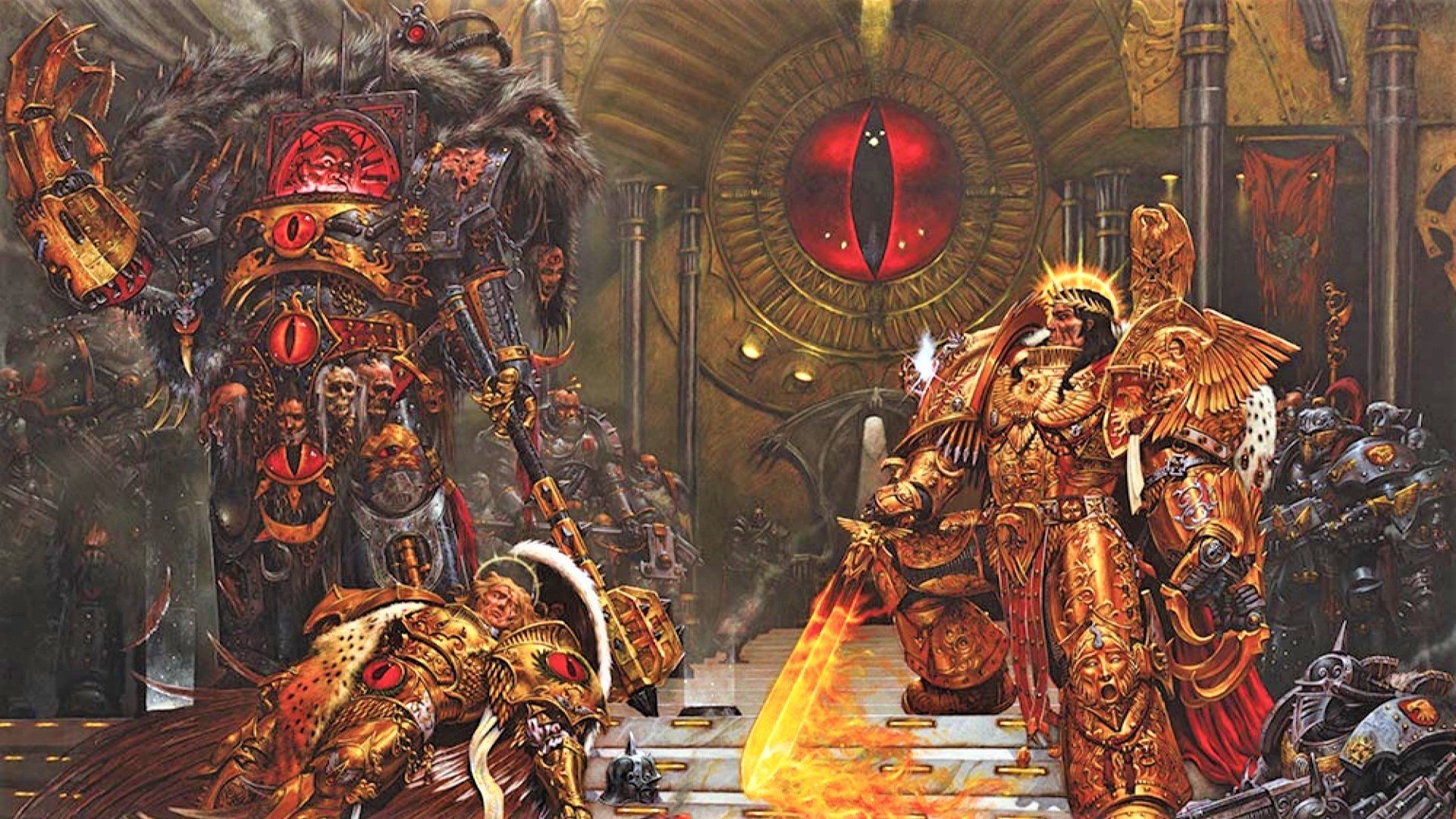
Corswain’s forces repelled repeated assaults by the Death Guard legion. The Dark Angels’ Librarius, and the first Imperial Saint, Euphrate Keeler, harnessed the combined psychic energy of thousands of refugees from the palace, successfully reigniting the beacon, sending a signal into the warp. This played a subtle, yet vital role in the Emperor’s psychic war against his fallen son Horus.
Crusade of Vengeance
Isolated from Terra, the Dark Angels pursued a punitive campaign against the home worlds of the Traitor Legions, hoping to draw them away from the Siege of Terra. The campaign was in vain – the Warmaster’s goals had passed far beyond the material realm.
Luther during the Horus Heresy
At the outbreak of the Horus Heresy, the rift between Jonson and Luther finally bore rotten fruit. Though Luther had kept to his post loyally for many decades, by the time Horus was appointed Warmaster Caliban was a changed world. Imperial settlement had turned it into a densely populated factory world, its forests ruined and its cities dense. Yet, against all reason, the great beasts of Caliban seemed to have returned.
Encouraged by the enigmatic master of rites known as Cypher, Luther delved deep into troves of lore recovered from the Knights of Lupus. He became convinced that the planet Caliban was irrevocably tainted by Chaos, a fact that would damn it to destruction at the Imperium’s hands should the truth ever come out. More, he was certain that Jonson too knew this, and had sent him and his warriors to the planet to die.
It is hard to know whether Luther, or any of his inner circle, succumbed to Chaos, directly or indirectly. Caliban was isolated from the main war zones, and at the outbreak of the war the diabolical nature of Horus Lupercal’s “allies” was unknown. Likewise, with the Dark Angels isolated from the rest of the Imperium for much of the war, and Jonson ever a terse and taciturn warrior, the fact that Luther opposed him did not necessarily mean that he had embraced Chaos.
Equally, the power of Chaos is pernicious and subtle. One can do its handiwork while believing you are its staunchest opponent.
The Scouring and the destruction of Caliban
After the Emperor’s costly sacrifice slew Warmaster Horus, the traitor Legions fled, first in disarray, and then with greater tenacity. Though abandoned by the powers of Chaos, they had conquered much of the Imperium, and the campaign to exterminate them – known as the Scouring – was long and bloody.
The Scouring eventually drove the traitor forces back into the warp/realspace overlap known as the Eye of Terra. At this time the Dark Angels fleet detoured to their homeworld Caliban.
To their surprise, when they arrived into the system, they were fired upon by the orbital defences of their home world. Jonson assumed that his erstwhile brother Luther had sided with the traitor cause, and ordered an orbital bombardment of the planet, while he launched a Teleport strike into the fortress monastery of the Order to confront his erstwhile brother.
When Jonson and Luther fought, the pair were matched like never before, Luther empowered by sorcerous secrets of Chaos he had uncovered in his years of research. Their mighty duel brought wrack and ruin, while Caliban strained under the impact of voidship lance strikes and munitions.
At the last, Luther struck the Lion a mortal blow – and then stopped, as if scales had fallen from his eyes. Realizing what he had done, he collapsed to the ground, unwilling to fight.
A great vortex of Chaos energy engulfed the tortured world, ripping it into pieces. Only the Chapter Monastery of the Dark Angels remained standing, protected by powerful void shields and clinging to a single lump of the planet’s crust.

The Rock
The Rock is all that remains of Caliban. Both the Chapter Monastery of the Dark Angels, and a miles-deep slab of bedrock from beneath it, survived the destruction of the Chapter homeworld. In the millennia since it has been fitted with drives, including the Tuchulcha device, and serves the Chapter as its flagship. It is one of the mightiest vessels in service within the Imperium.
All Fortress Monasteries are vast, and the Rock – dating from the time of the Legions – is far larger than most. The arcane secrets of the ancient Order are stamped into its bedrock, and beneath that the winding dungeons have accumulated forbidden knowledge and arcane lore beyond measure.
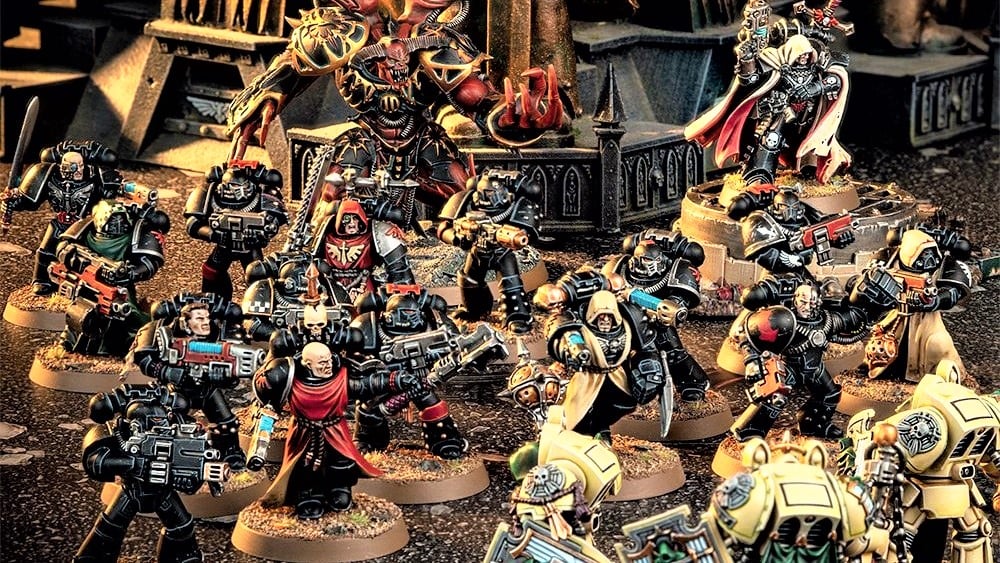
The Fallen
When Caliban was destroyed, the Dark Angels who sided with Luther were swallowed by the Warp, transported through time and space and out of the clutches of their avenging brothers. These Fallen brothers are a shame beyond uttering to the Dark Angels – and a secret they guard with utmost commitment.
The Dark Angels feared that, should word ever emerge of the treachery of half of their Legion, they would be destroyed as traitors. This fear was not unfounded: their motives and actions within the maelstrom of the Heresy had not always been clear to other Legions. In the febrile atmosphere of mistrust that followed the Heresy, purges were common.
So the Dark Angels committed to hunting down all those who might have knowledge of this event. The hunt for the Fallen continues to this day, for while a single traitor Dark Angel lives, their dread secret may yet be uncovered.
The Inner Circle
The Dark Angels guard the secret of the Fallen closely. The training of battle brothers includes induction into a progressive series of mysteries, some of them adaptations of the Calibanite Order’s mystery rites, others created in the millennia since. These serve to prepare the brother for ever greater secrets, and an ever greater burden of silence.
Only when a brother is inducted into the Inner Circle is he permitted to learn the truth of the Fallen, and even then, not all at once. The process of uncovering the Chapter’s shameful past lasts longer than many brothers live. The veteran Deathwing are all members of the Inner Circle, as are the Chapter’s command cadre, and the Interrogator Chaplains of the Reclusiam.
The Deathwing
The veteran first company of the Dark Angels is known as the Deathwing. These dour and single-minded individuals are not merely survivors of many battles, but known to be profoundly pure of thought and singular of will, for they are all also elected to the Inner Circle, privy to the Chapter’s darkest secrets.It is the Deathwing’s solemn duty to pursue, persecute, and capture the Fallen, wherever they may be found.
The Deathwing has adopted bone white livery for its armor. As Chapter lore has it, this was first adopted by a cadre of Deathwing terminators, before they boarded a Space Hulk to cleanse it of a Genestealer Infestation. Symbolically, it indicates that they accept their deaths as inevitable – that they are already dead.
The Dark Angels have enough Space Marine terminator armor that the entire Deathwing can fight in terminator plate if required. The Deathwing makes extensive use of teleport strikes, delivering overwhelming force onto a critical target and overwhelming it utterly, then enduring the enemy counter-assault obdurately.
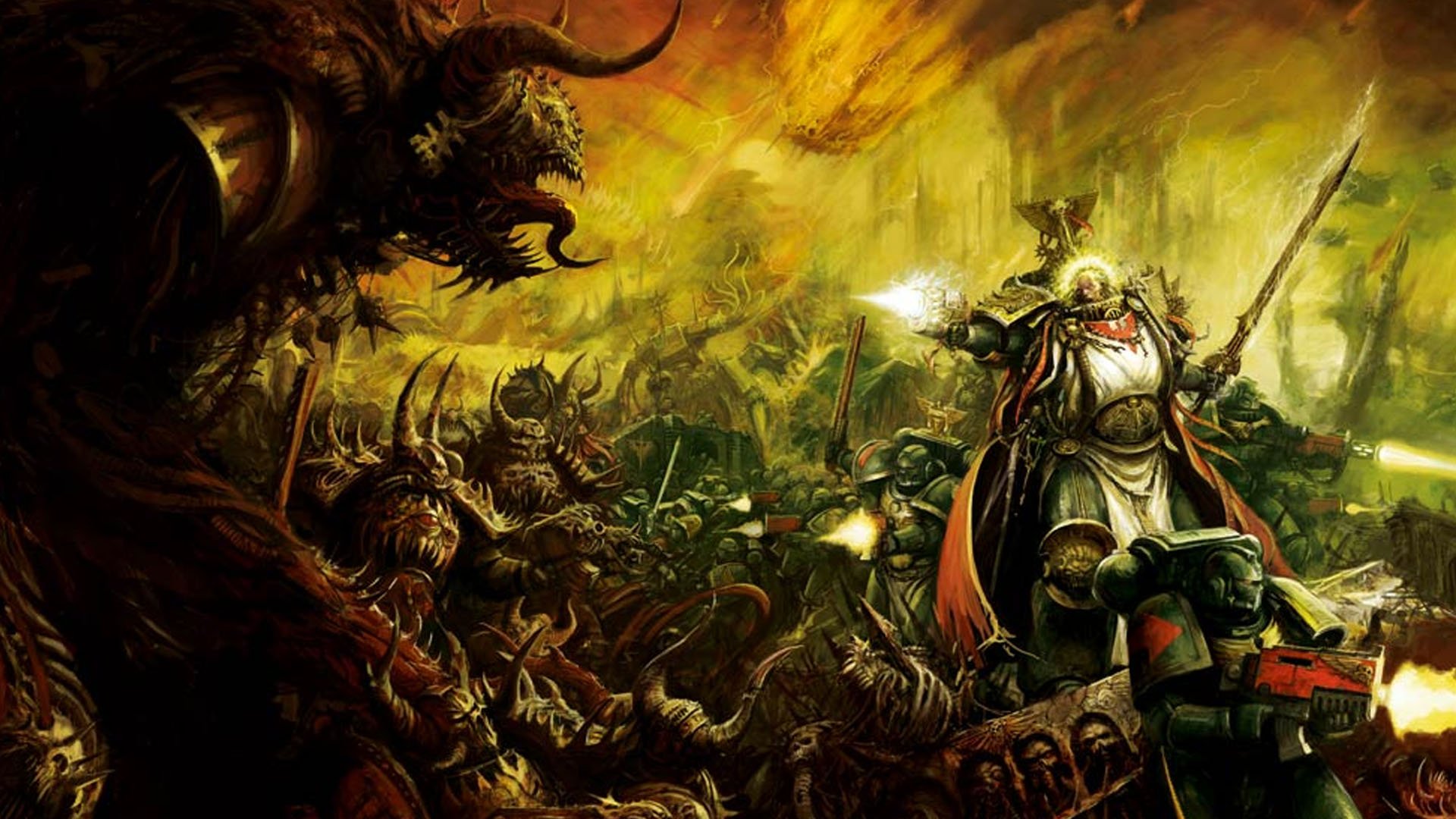
The Dark Angels since the Horus Heresy
After his climactic duel with Luther, the Lion vanished. He was not dead, nor drawn into the realm of Chaos. Rather, he was taken by the ‘Watchers in the Dark’, the strange, warp-sensitive Xenos that had inhabited Caliban since before the coming of the Imperium. He rested in a place unknown, alive yet torpid, sleeping until the day when he was roused to fight for the Imperium once more.
Luther, imprisoned
The traitor Luther was not slain in his battle with the Lion. He was captured by the Chapter, imprisoned in the deepest dungeons of the Rock. Known only to the Supreme Grand Master of the Chapter, this deepest and darkest secret of the Dark Angels languished for millennia in the lowest depths of the Fortress Monastery.
Luther is quite mad. Generations of Grand Masters have attempted to extract a confession from him, or to wring secrets from his lips. Not everything he says is a lie, but the truth is not always helpful – it was Luther who first told the Chapter that the Lion had been taken by the Watchers in the Dark.
Luther, freed
At the end of the 41st millennium, Abaddon the Despoiler’s 13th Black Crusade brought about an apocalyptic event long-heralded – the destruction of the Cadian Gate. With it, an ancient system of warp-dampening pylons constructed in ages past by the Necrons was brought to ruin. The galaxy split in two as a terrifying new warp rift, known as the Cicatrix Maledictum, spilled forth from the Eye of Terror.
This tumult had dire ramifications for the Imperium as a whole, dividing half of the Imperium from the light of the Astronomicon beacon on Terra. This isolated realm was known as Imperium Nihilus.
As this great calamity unfolded, an army of Daemons assaulted the Rock, led by the Fallen Daemon Prince Marbas. Though their ingress caused great destruction, they seemingly achieved little of tactical purpose.
However, Grand Master Azrael knows differently. For as the Daemons disappeared from reality, so too did a prisoner vanish with them. Luther has gone, and where he is now remains a mystery – but rumors speak of a great force of the Fallen mustering in Imperium Nihilus.
The return of Lion El’Jonson
The Lion awoke into a dream of lost Caliban, a realm that might be the Warp and might be something else, an infinite forest that stretches between worlds. Guided by the Watchers in the Dark, he made his way back to the realm of the living.
Hardly had he returned to the realm of the living when he was thrown into battle. At the Battle of Idolatros, The Lion saved the Blood Angels Chapter Master Dante from the rampaging Daemon Primarch Angron. He was able to drive his accursed brother back into the warp, and secure the retreat for the gathered hosts of loyalists.
Since then he has been dubbed The Knight of Nihilus. While he is an active leader of the Dark Angels, he comes and goes as he pleases, using his ability to Forestwalk through parallel dimensions to arrive wherever he is needed. His blade alone is enough to turn the tide of battle, and he has delivered countless worlds that faced near certain annihilation
The Risen
When the Lion encounters the Fallen – or when they are brought under the knives of the Interrogator Chaplains – their fate is not certain. The Lion has spared some, and he has elevated these warriors into his personal retinue, the Risen. They alone recall the days of the Heresy, and the ways of old Caliban.
Who are the Dark Angels characters?
More than almost any other Space Marines Chapter in Warhammer 40k (except perhaps the Ultramarines), many Dark Angels characters appear extensively in novels and have playable models for the tabletop.
- Lion El’Jonson, Primarch of the Dark Angels
- Azrael, Supreme Grand Master
- Ezekiel, Grand Master of Librarians
- Belial, Grand Master of the Deathwing
- Sammael, Grand Master of the Ravenwing
- Master Lazarus
- Brother Asmodai
- Primaris Lieutenant Zakariah
- Cypher, the Fallen
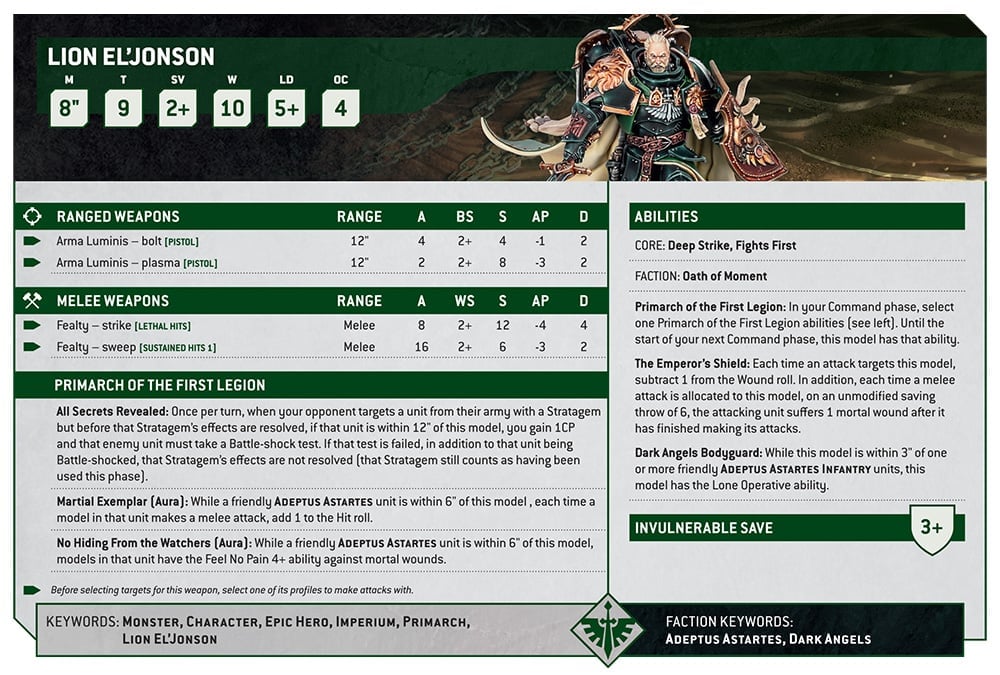
Lion El’Jonson, Primarch of the Dark Angels
The Primarch Lion El’Jonson is an utter melee monster, with the melee prowess to go toe to toe with a Chaos Knight, and a choice of three powerful aura buffs that can disrupt your opponent’s stratagems, buff fellow Dark Angels’ melee effectiveness, or protect your allies from mortal wounds.
Azrael, Supreme Grand Master
The current head of the Dark Angels is Azrael, Supreme Grand Master and Keeper of the Truth. This lofty position means he’s aware of many of the Dark Angels’ secrets, including the existence of Luther, locked in his eternal prison.
He’s armed with the Sword of Secrets, his armor is known as The Protector, and he’s followed everywhere by one of Caliban’s mysterious creatures, known as a Watcher in the Dark, who carries his venerable helm, the Lion Helm.
Azrael has recently crossed the Rubicon Primaris, becoming a Primaris Space Marine. His mini first appeared in the Wrath of the Soul Forge King battle pack, battling against the Daemon Vashtorr the Arkifane as part of the Arks of Omen narrative.
On the tabletop, Azrael is a powerful force multiplier equally adept leading a squad of Bladeguard Veterans or a Hellblaster Squad. His Masterful Tactician ability grants you 1CP at the start of your Command Phase every round, while his Supreme Grand Master ability grants the unit he’s attached to Sustained Hits with both ranged and melee weapons.
Ezekiel, Grand Master of Librarians
The leader of the Dark Angels’ Librarius, Ezekiel, Grand Master of Librarians is renowned as one of the most powerful psykers the force has fielded since Lion El’Jonson’s time. When not at war, you will find Ezekiel working to maintain the Dark Angels’ history, ensuring that what has passed is never forgotten.
On the tabletop, Ezekiel can join Assault Squads, Command Squads, Tactical Squads, or Vanguard Veteran Squads, which he will grant +1 Attack in melee via his Book of Salvation and Feel No Pain 4+ against Psychic Attacks thanks to his Psychic hood.
He has an exceptionally powerful character-hunting psychic power, Mind Wipe, and the useful Engulfing Fear psychic ability which forces an enemy unit to take a Battle-Shock test in your shooting phase.
Belial, Grand Master of the Deathwing
Belial, Grand Master of the Deathwing, leads the bone-colored Terminators who stalk the battlefield as stalwart masters of destruction. Clad in ancient Terminator armor, Belial is one of the most fearsome warriors the Dark Angels have ever seen, with a loyalty unmatched among even his sturdy brethren.
On the tabletop, he’s a character assassin. Both his ranged and melee weapons have the Precision ability, letting him target enemy characters while their bodyguard is still standing, and his Grand Master of the Deathwing ability means that when the unit he leads scores Critical hits, they can treat those attacks as having Precision.
He also dies hard. For every melee attack allocated to Belial, there’s a 2+ chance of inflicting a mortal wound on the unit that made the attack (though you’re capped at rolling six dice per unit).
Sammael, Master of the Ravenwing
The Master of the Ravenwing, Sammael leads the Dark Angels’ mobile strike force into battle with a reckless abandon that borders on foolhardiness. Known for his ability to put armed forces into combat with shocking speed, Sammael’s personal steed is a relic jetbike, one of the last functioning examples available to all of the Adeptus Astartes.
He can lead squads of both firstborn and Primaris Astartes bikers, granting them the ability to shoot after advancing. Once he engages an enemy unit (other than a vehicle or monster) in melee, that enemy must risk Desperate Escape tests any time it wants to fall back from melee.
Master Lazarus
If you encounter Master Lazarus, you’ll be most struck by how calm and collected he is, even in the midst of battle. If, however, you happen to be a sorcerer, one wielding the dark arts of the Warp, then you’ll see his fury unleash itself on you, along with his blade, Enmity’s Edge.
Lazarus’ Intractable Will ability gives any models in his unit that are destroyed in melee before they get a chance to fight a 4+ chance to make their attacks before they’re removed from the table. He definitely wants to join an Assault Intercessor or Bladeguard Veteran squad.
Brother Asmodai
There are many things to fear about the Dark Angels, but, in some ways, Brother Asmodai is the most fearsome of them all. Acting as their Master Interrogator-Chaplain, he is responsible for rooting out heresy or deviation, no matter what form it takes. Zealous and cold-hearted, Asmodai is a terror on the battlefield – but so much scarier if you meet him in an interrogation chamber.
Asmodai’s reputation as a Feared Interrogator precedes him into battle, and enemy characters within 6″ of him at the start of the Fight Phase need to make a Battle-Shock test with a -1 penalty. Should he slay an enemy character in combat, you’ll gain 1CP.
Primaris Lieutenant Zakariah
Zakariah is a Primaris Lieutenant. Despite being one of the newer warriors in the Dark Angels, Zakariah has proved his worth many times over, earning the robe and cowl of a Lieutenant with ease.
Cypher, the Fallen
Finally, we come to Cypher, the Fallen. You won’t field Cypher with the other Dark Angels – in fact, his rules are in Index Chaos Space Marines – but he’s utterly entwined with them. The leader of The Fallen, he is the most hunted person in the entire galaxy; even a whisper of his passing will cause a full crusade to spill out from the Rock.
His goals are unknown, and it’s not even known if this is the same Cypher seen during the Horus Heresy. All we know is that his movements seem to centre on Terra – and he’s getting closer with each passing day.
Dark Angels Successor Chapters
The Dark Angels suffered grievously during the Horus Heresy but retained enough strength that it could be split into several smaller Dark Angels Successor Chapters in accordance with the reforms in Roboute Guilliman‘s Codex Astartes.
The Angels of Absolution, Angels of Redemption, and Angels of Vengeance were all part of the second founding, formed from veterans of the Dark Angels. These chapters were bound by the same bonds of secrecy as the Dark Angels, and have maintained a chapter culture very similar to that of their parent.
Many Dark Angels successor chapters have been founded in the millennia since, including new Primaris chapters created by the genecraft of Belisarius Cawl.
Dark Angels books
As one of the most popular Space Marine chapters, Black Library has published a lot of Warhammer 40k books about the Dark Angels. Most Dark Angels books were written by veteran Games Workshop writer Gav Thorpe. Since they’ve been around for so long, they’re now collected into various omnibus editions:
| Title | Author | Collected in |
| Angels of Darkness | Gav Thorpe | Legends of the Dark Angels |
| The Purging of Kadillus | Gav Thorpe | Legends of the Dark Angels |
| Azrael | Gav Thorpe | Legends of the Dark Angels |
| The Eye of Ezekiel | CZ Dunn | Legends of the Dark Angels |
| Various short stories | CZ Dunn | Legends of the Dark Angels |
| Ravenwing | Gav Thorpe | Legacy of Caliban |
| Master of Sanctity | Gav Thorpe | Legacy of Caliban |
| The Unforgiven | Gav Thorpe | Legacy of Caliban |
| Various short stories | Gav Thorpe | Lords of Caliban |
| The Lion: Son of the Forest | Mike Brooks | N/A |
| Cypher: Lord of the Fallen | John French | N/A |
| Luther: First of the Fallen | Gav Thorpe | N/A |
| Primarchs: Lion El’Jonson | David Guymer | N/A |
| Horus Heresy book 6: Descent of Angels | Michael Scanlon | N/A |
| Horus Heresy book 11: Fallen Angels | Mike Lee | N/A |
| Horus Heresy book 38: Angels of Caliban | Gav Thorpe | N/A |
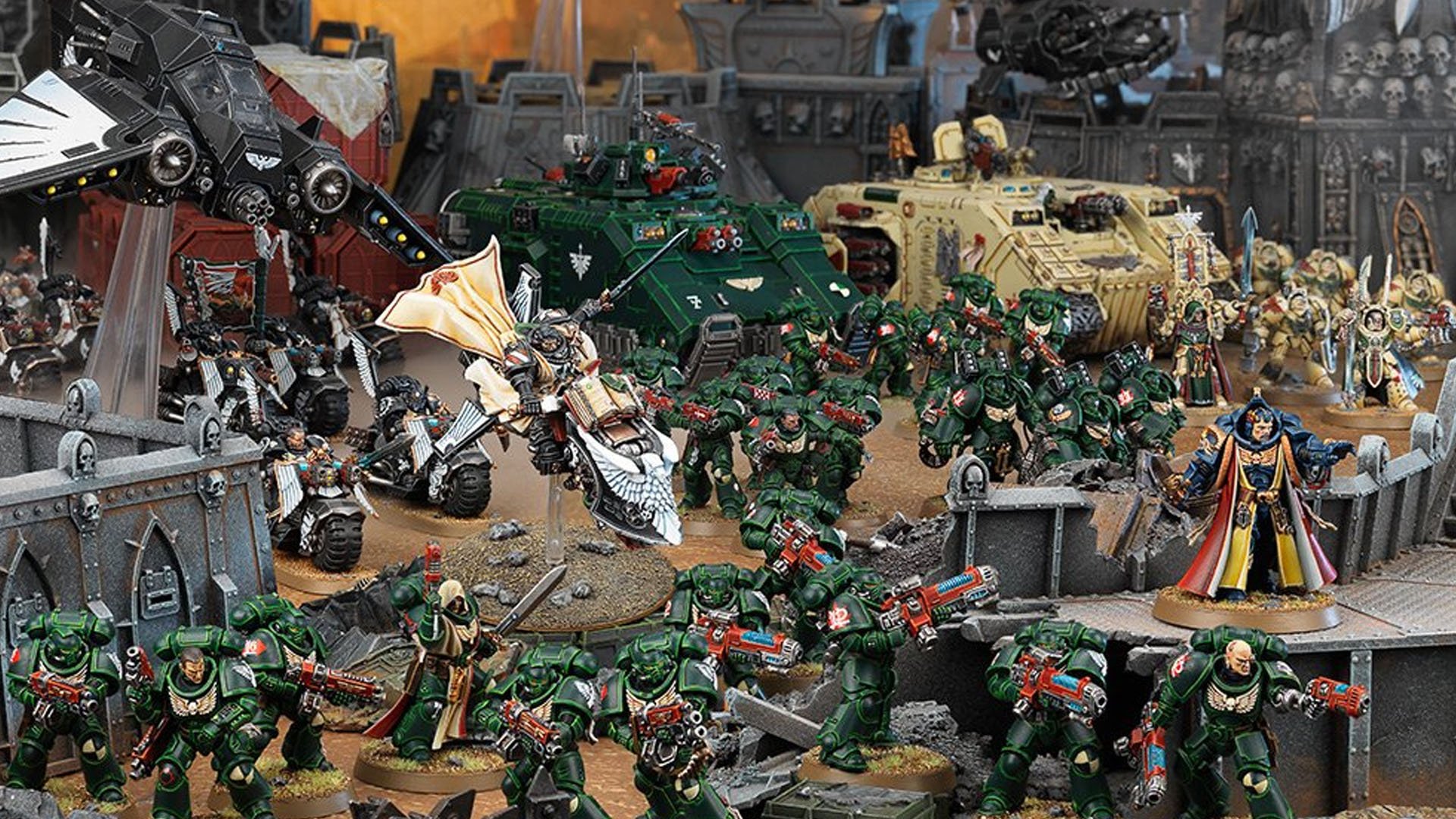
Unique Dark Angels units
Many unique Dark Angels units are fielded by no other Space Marine chapters. The elite Terminators of the Deathwing are an unbreakable anvil, while the bike and speeder mounted knights of the Ravenwing are an irresistible hammer, between which the foes of the Imperium are easily crushed.
| Unit | Role |
| Inner Circle Knights | Elite bodyguard infantry |
| Deathwing Terminator Squad | Elite heavy infantry |
| Deathwing Knights | Elite super-heavy melee infantry |
| Ravenwing Command Squad | Biker commander and bodyguard |
| Ravenwing Black Knights | Elite bikers |
| Ravenwing Darkshroud | Anti-grav support vehicle |
| Ravenwing Landspeeder Vengeance | Anti-grav gunship |
| Ravenwing Dark Talon | Ground-attack flyer |
| Nephilim Jetfighter | Anti-air flyer |
Warhammer 40k 10th edition Dark Angels army rules
In Warhammer 40k 10th edition Dark Angels share the Space Marines’ Oath of Moment army rule. This allows them to pick a single enemy unit each battle-round, against which their whole force can reroll failed rolls to hit and to wound.
You can include any Space Marine datasheets in a Dark Angels force, with the exception that you can’t include models with any other Chapter Keywords. If a model has no Chapter keyword that’s fine.
The Dark Angels have an additional Codex with unique units – our Codex Dark Angels review explores what it does differently from previous editions, and how it differs from the free Index available at the start of Warhammer 40k 10th edition.
Dark Angels Unforgiven Task force detachment
The first Dark Angels Detachment for 10th edition, Unforgiven Task Force, was published in the free Index, and is pretty much unchanged in the Dark Angels Codex supplement. It provides a simple but powerful special ability, as well as several Warhammer 40k Stratagems and enhancements. Whenever a unit from the army becomes Battle-shocked, its Objective Control stat becomes one instead of zero.
This seems minor but it’s huge, allowing your units to hold onto objectives reliably even when they’re below half-strength, or subjected to the new weapons and abilities that can force Battle-shock tests, like the Tyranids Shadow in the Warp.
Note, though, that your Battle-Shocked units still can’t use many Stratagems and must make a Desperate Breakout test when falling back from melee.
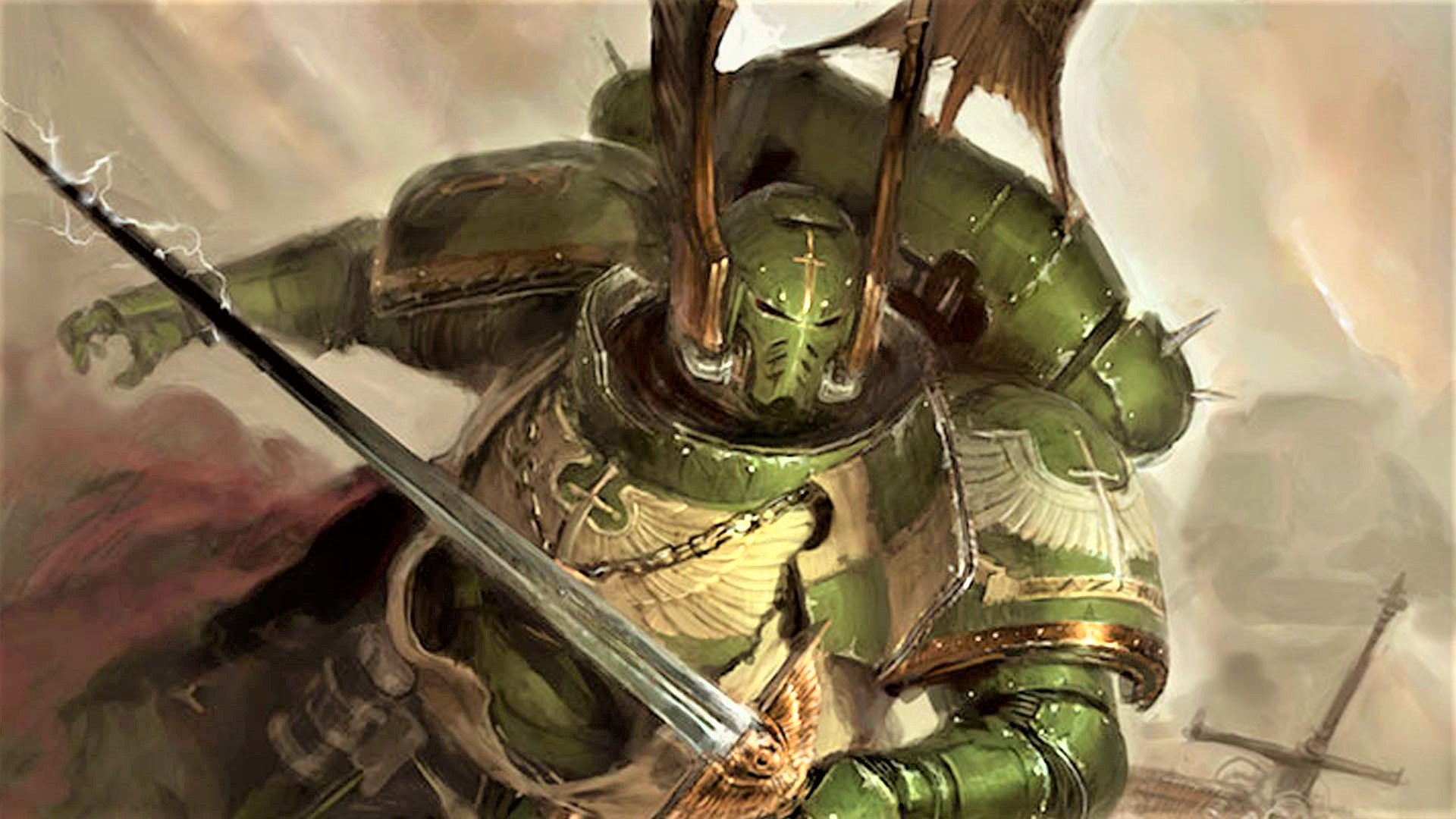
Unforgiven Task Force Stratagems
There are six Unforgiven Task Force Stratagems. These can only target your Space Marines, so if you’ve added some Agents of the Imperium Arbites or an Imperial Knight Freeblade, they can’t benefit:
| Stratagem | Cost | Effect |
|---|---|---|
| Unforgiven Fury | 1CP | Select a unit that’s about to fight or shoot; it gains the Lethal Hits weapon ability this phase. If one of your units is Battle-shocked, this unit scores Critical Hits on Hit rolls of 5+. |
| Intractable | 1CP | Pick a unit that’s just fallen back; it can shoot or charge this turn. |
| Armour of Contempt | 1CP | Pick a unit that’s been targeted by enemy shooting or melee attacks; worsen the AP of those attacks by one. |
| Fire discipline | 1CP | Pick a unit that’s about to shoot; this shooting phase, its ranged weapons have the Assault, Heavy, and Ignores Cover abilities. |
| Grim Retribution | 1CP | Pick a unit just after one or more models is destroyed by an enemy shooting attack: your unit can fire back at it, provided it’s an eligible target. |
| Unbreakable Lines | 2CP | Just after an enemy unit charges, pick one of your units in engagement range with it; subtract one from wound rolls that target that unit this turn. |
Unforgiven Task Force Enhancements
The Unforgiven Task Force has access to four Dark Angels enhancements. They increase in power while the bearer is Battle-shocked.
| Enhancement | Effect | Battle-shock bonus |
|---|---|---|
| Shroud of Heroes | The first time the bearer is destroyed, roll a D6. On a 2+ set it back up as close as possible to where it was destroyed with three wounds remaining, not engaged with any enemy models. | If it was Battle-shocked when it was destroyed, it returns at full health. |
| Stubborn Tenacity | While the bearer is leading a unit, the unit gets +1 to hit if it’s below Starting Strength | Addtional+1 to wound |
| Heavenfall Blade | Bearer gets +1 Attack, +1 Strength, +1 Damage on melee weapons | Bonus increases to +2 |
| Pennant of Remembrance | Bladeguard, Primaris, or Terminator Ancient only: while the bearer is leading a unit, the unit has Feel No Pain 6+ | Feel No Pain 4+ |
Dark Angels Codex Supplement Detachments
As well as the Unforgiven Task Force that was included in the Dark Angels Index, there are two Detachments that are only found in the Dark Angels Codex.
The Inner Circle Task Force is themed around Deathwing models – Terminators, Land Raiders, Repulsors, Dreadnoughts, and other Veterans. This elite force is renowned for staking a claim on an objective and pursuing it relentlessly, represented in game by picking a Vowed objective at the start of each battle round. Your infantry units will gain a bonus to wound enemies unlucky enough to be standing next to the objective you’ve vowed to claim.
The Company of Hunters is focused on Ravenwing units, and grants all Outrider units the Battleline keyword, letting you take six units of each. Units can shoot in the same turn that they advance or fall back, making this a very mobile gunline – though its stratagems and enhancements are reserved to just your Ravenwing models.
Dark Angels strategy
Now you know the backstory and a bit of the lore surrounding the Dark Angels, but how do they play on the battlefield?
The Dark Angels are often thought of as three armies in one, as they have a core of regular Space Marines, surrounded by fast-moving Ravenwing units, and ultra-resilient Terminator Deathwing units.
In ninth edition 40k the Deathwing and Ravenwing were each a subfaction within a subfaction, that functioned most effectively on their own. That’s an option in 10th edition, with the Inner Circle Task Force or the Company of Hunters detachments, but the Unforgiven Task Force is still a very effective Detachment if you want to build a mixed arms list.
Focusing just on Terminators and Bikers will make for an expensive list. If you go this route you won’t have many bodies to throw at things. This makes the board control game harder.
Bikers mitigate the problem by being very maneuverable, but they’re squishy – you need to concentrate force to delete enemy units, and deny your opponent the ability to strike back effectively. Terminators are the opposite – extremely durable, but slow moving. You need to hit your target hard and do devastating damage, because after your initial teleport strike you won’t have much opportunity to maneuver.
The Dark Angels’ massive selection of characters gives you plenty of room to experiment adding unique buffs to your units, even beyond what normal Space Marines have to choose from.
Dark Angels Combat Patrol box set
The Dark Angels Combat Patrol is a great starting point for any Space Marine force, let alone the Dark Angels. The current Combat Patrol box set contains 10 Space Marine Intercessors, five plasma-gun wielding Hellblasters, a Captain in Gravis armor, three Bladeguard Veterans, and Dark Angels upgrade sprues. It’s a solid infantry core for any force.
If you want to face off against another Combat Patrol box you can use the Combat Patrol rules. These are a little simpler compared to the rules in the Dark Angels Index, with different enhancements and stratagems to make this list balanced against the other boxes.
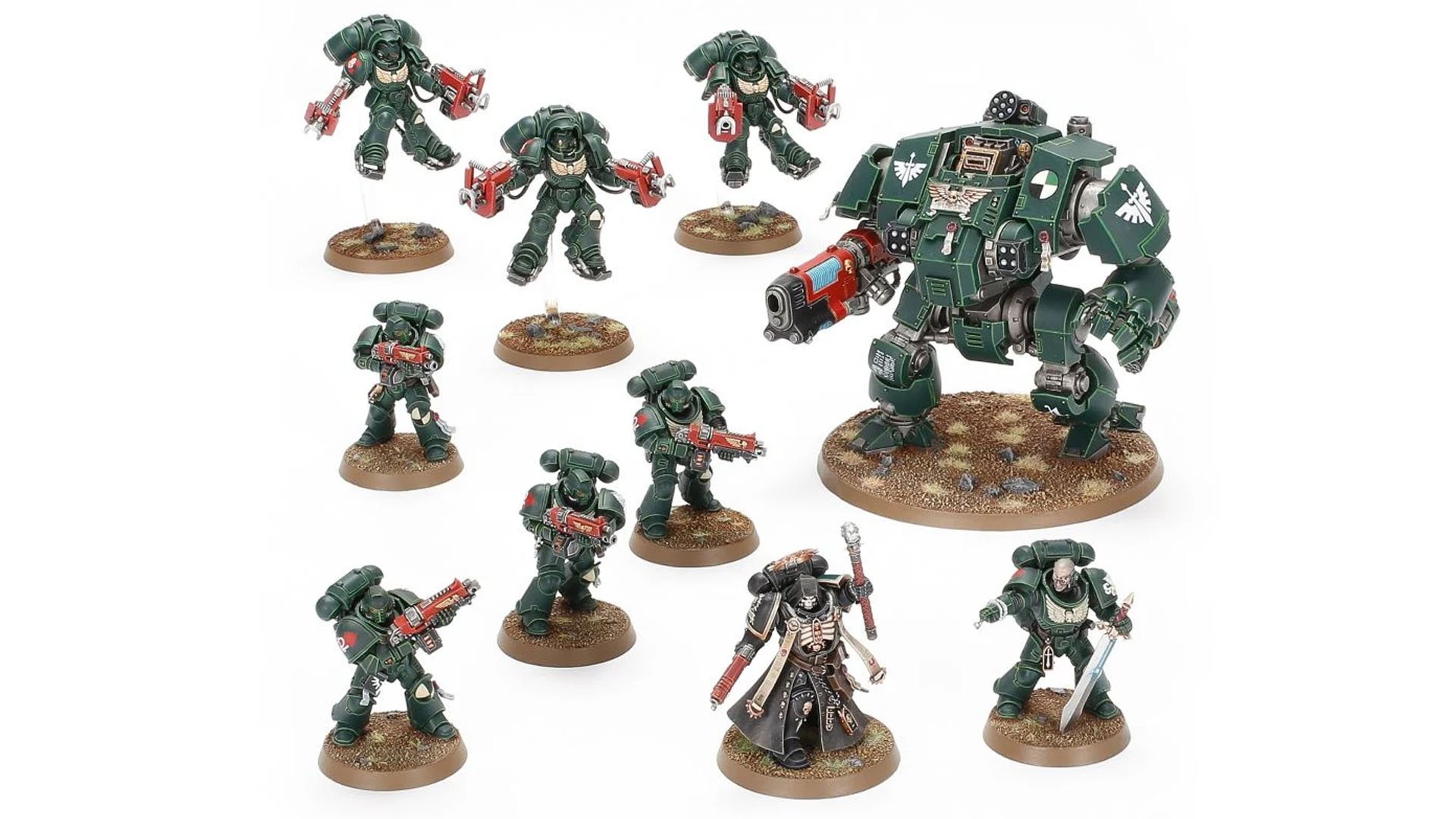
An earlier combat patrol, Mordekai’s Judgement, is still on sale in some stores. It contains a Primaris Chaplain, three Interceptors, a Redemptor Dreadnought, and five Primaris Intercessors, plus some upgrade sprues to ensure they are appropriately Dark and Angelic. Free Dark Angels Combat patrol rules for that combat patrol are still available from Warhammer Community.
To add speed, you’ll want to look at a wing of Ravenwing bikes, and, to add a hardy element to your army, it’s worth taking a peek at a Deathwing Knights Terminator squad.
Dark Vengeance
Dark Vengeance was the Warhammer 40k starter set for both the sixth and seventh editions of the game. It pitted a force of Chaos Space Marines against the Dark Angels and contained two sets of unique models. While Dark Vengeance is long out of production, the models were available direct from Games Workshop on a made-to-order basis in December 2019.
The 21 Dark Angels figures in Dark Vengeance were:
- Interrogator Chaplain
- Librarian
- Captain
- Ravenwing Bikers x 3
- Deathwing Terminators x 5
- Tactical Squad x 10
Dark Angels Horus Heresy rules
The Dark Angels were the first Legion Astartes and, as they would have it, the template on which the other legions were built. They certainly demonstrated a broad spectrum of tactical doctrines, a theory of war known as the Hexagrammaton.
Every Legiones Astartes unit in a Dark Angels Horus Heresy army must be allocated to one of the six Wings of the Hexagrammaton, granting them a particular bonus. Though any unit can be added to any Wing, there are obvious synergies between certain unit types and certain Wings.
| Hexagrammaton Wing | Benefit |
| Stormwing | +1 to hit with bolter, combi-bolter, and boltpistol shooting attacks |
| Deathwing | +1 to hit with swords; vehicles get +1 Strength when ramming |
| Dreadwing | Flame, plasma, volkite, phosphex weapons get -1 Strength when targeting Dreadwing, and Poisoned weapons are treated as one level weaker |
| Ironwing | Re-roll to-hit rolls of 1 against Vehicles; Vehicles in this Wing make Snap Shots at BS2 |
| Firewing | +1 to wound when attacking a unit containing an Independent Character |
| Ravenwing | Non-vehicles add +1″ to runs; Cavalry may re-roll failed Shrouded damage mitigation rolls. Vehicles add +2″ when moving at Cruising speed. |
Dark Angels Rites of War
There are more Dark Angels Rites of War than there are for any other Space Marine legion. Each focuses on one of the Wings of the Hexagrammaton and requires your Warlord and certain units to be drawn from that wing. Certain units will become much more accessible to your force.
| Rite of War | Wing | Focus |
| The Steel Fist | Iron Wing | Armored company – Predators are Troops; Kratos are elites; Infantry can take Land Raiders and Spartans as transports. |
| The Eskaton Imperative | Dreadwing | Warcrimes – Destroyers and Interemptors become Troops; terrain becomes more difficult and dangerous for your opponent; dangerous terrain gives you a bonus to wound. |
| The Storm of War | Stormwing | Massed infantry – Units with at least 20 models may be led by a Centurion which doesn’t fill an HQ slot; units led by a character are Stubborn; basic infantry can also fill Elites and Fast Attack slots. |
| The Unbroken Vow | Deathwing | Elite – Veterans and Terminators may be selected as Troops, gain Heart of the Legion; Independent characters get extra attacks near objectives. |
| The Seeker’s Arrow | Ravenwing | Rapid assault – bikes and jetbikes become Troops; cavalry characters gain Rampage (2); cavalry and infantry can Outflank. |
| The Serpent’s Bane | Firewing | Assassination – Seeker squads can be troops; you get +1 to hit three Primarch, HQ, Elite, or Lords of War units of your opponents’ choice, and characters get extra attacks against these targets; infiltrate three infantry units. |
If you’re a fan of green armored Space Marines but would prefer a slightly less dour bunch, read our guide introducing the Salamanders. If you’re a fan of knightly orders but can’t be having with all of this sci-fi palaver, keep an eye on our guide to Warhammer: The Old World factions – the Bretonnians should be just what you’re looking for.
